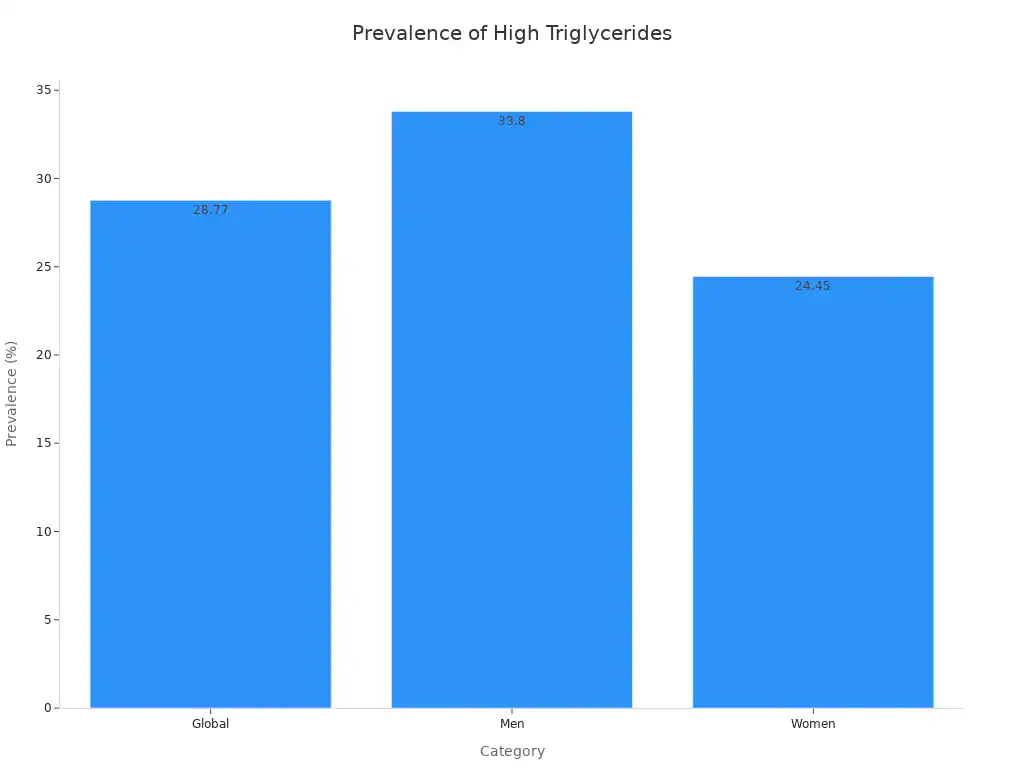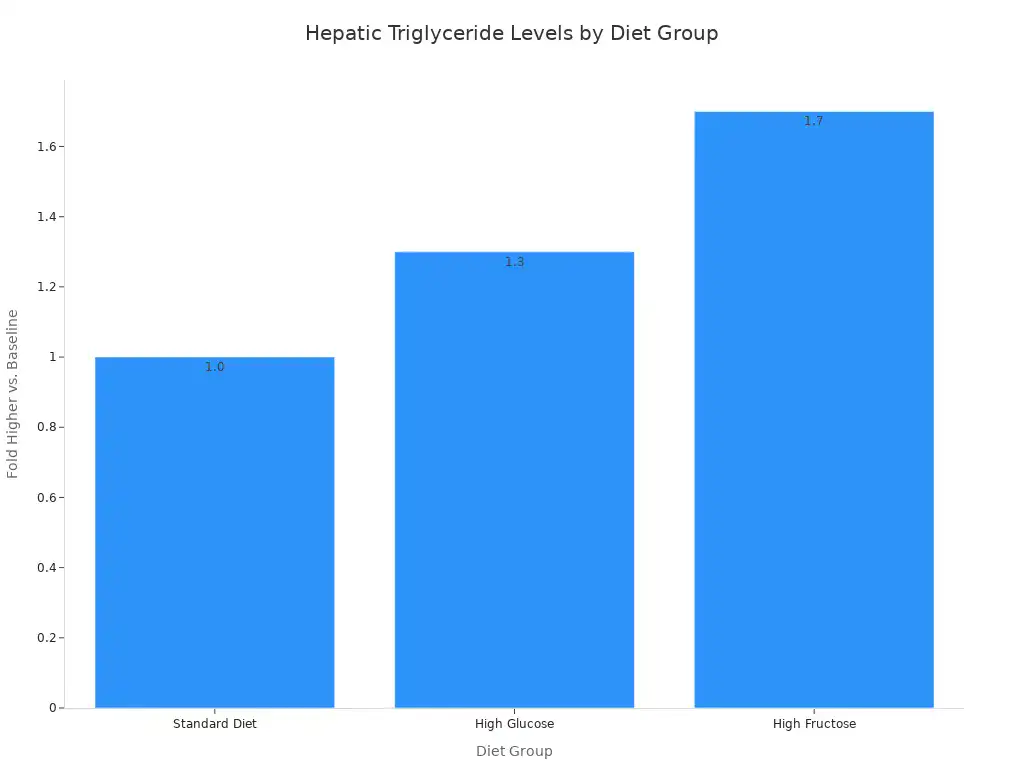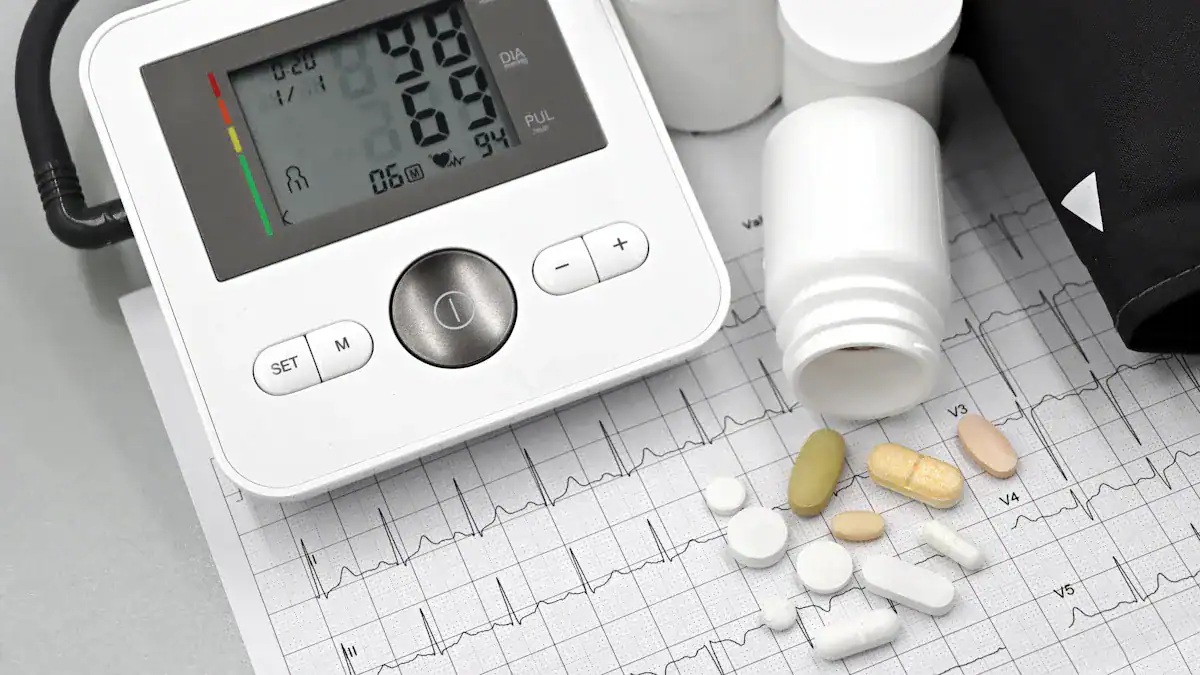
You worry about your health, and understanding your triglyceride levels is a crucial part of that. These fat particles in your blood significantly impact your well-being. Knowing age-specific guidelines for triglyceride levels is important. This blog post provides a clear, age-based chart. It explains what your triglyceride numbers mean for your personal risk. This information empowers you to take control of your cardiovascular health. Many adults face this challenge; over 25% of US adults have elevated triglycerides, meaning levels equal to or greater than 150 mg/dL.
Time Period | Percentage of US Adults with Elevated Triglycerides (≥ 150 mg/dL) |
|---|---|
2001–2004 | 33.3% |
2009–2012 | 25.1% |
Globally, the prevalence of high triglycerides is 28.77% and has increased over time, presenting a significant cardiovascular risk.

Key Takeaways
Triglycerides are fats in your blood. Your body uses them for energy. High levels can harm your heart.
Your triglyceride levels change with age. Adults should aim for levels below 150 mg/dL. Young people should aim for levels below 90 mg/dL.
High triglycerides increase your risk for heart disease and stroke. They can also lead to other health problems like pancreatitis.
You can lower high triglycerides. Eat healthy foods, exercise regularly, and manage your weight. Sometimes, medicine is also needed.
Regular check-ups are important. They help you know your triglyceride levels. This helps you keep your heart healthy.
What Are Triglycerides?
Defining Triglyceride
Triglycerides are a type of fat, or lipid, found in your blood. Your body uses them for energy. A triglyceride molecule is an ester. It forms from glycerol and three fatty acids. Glycerol has three alcohol groups. Each group reacts with a fatty acid. This creates three ester groups. The three fatty acids can be identical or different. Their chain lengths often vary. Common lengths are 16, 18, or 20 carbon atoms for a single triglyceride. Your body makes triglyceride. You also get triglyceride from the foods you eat.
Triglycerides and Body Energy
The main job of triglyceride is to store energy. When you eat, your body turns extra calories into triglycerides. It then stores these triglycerides in fat cells. Later, hormones release these triglycerides for energy between meals. This process gives your body fuel. High levels of triglycerides can be harmful.
It is important to understand that triglycerides are different from cholesterol. Both are lipids in your blood. But they have different functions. Cholesterol helps build cells and hormones. Triglycerides primarily store unused calories. You need both for good health. However, too much of either can cause problems. Monitoring your triglycerides helps you manage your health. Healthy triglycerides levels are key for your heart.
Your Triglyceride Levels By Age
Understanding your triglyceride levels means knowing what numbers are healthy for your age. These numbers are not fixed. They can change throughout your life. You need to know the normal range for your age group. This helps you understand your personal health picture.
Understanding Triglyceride Normal Range
You want to keep your triglyceride levels in a healthy range. For adults, a healthy triglyceride level is below 150 mg/dL. Many healthcare providers consider this the normal range. Optimal levels are even lower, ideally under 100 mg/dL. These classifications help doctors assess your cardiovascular risk. For males, a normal range is often 40-160 mg/dL. For females, it is 35-135 mg/dL. These healthy triglyceride ranges are important for your heart.
Age-Specific Triglyceride Levels
Your triglyceride levels can change as you get older. Here is a chart to help you understand the different ranges:
Category | Triglyceride Level (mg/dL) | Interpretation |
|---|---|---|
Adults (20+ years) | ||
Normal | Below 150 (ideally under 100) | Healthy range, low risk |
Borderline High | 150–199 | Increased risk |
High | 200–499 | Significant risk |
Very High | 500 or higher | Very high risk, potential for pancreatitis |
Young People (10-19 years) | ||
Normal | Below 90 | Healthy range |
High | 130 or higher | Increased risk |
Triglyceride levels generally rise with age. In your 20s and 30s, your levels might stay stable if you have healthy habits. However, your metabolism slows in your 30s and 40s. This can lead to higher triglyceride levels.
Middle age, from your 40s to 60s, often shows the highest triglyceride levels. This is true especially for men. Reduced physical activity and hormonal changes play a role. Women may see a big increase after menopause.
After age 70, triglyceride levels might level off or even drop a little. This can happen due to diet changes or other health conditions. This shows how triglyceride levels change with age. For young people, specifically children aged 10-19, triglyceride levels in children should ideally stay below 90 mg/dL. The National Heart, Lung, and Blood Institute confirms this normal triglyceride range. Levels above 130 mg/dL are high for this age range. Understanding your normal triglyceride range by age helps you manage your health.
Gender Differences in Levels
You might wonder if triglyceride levels differ between men and women. Women generally have lower fasting and postprandial triglycerides than men. A study on young adults found women had lower total triglycerides.
This difference was consistent. However, a study of hospitalized adolescents and young adults showed no major sex differences in high triglyceride levels. About 9.6% of males and 8.1% of females had high triglyceride levels. This suggests that for some age groups, the range might be similar. You should always discuss your specific triglyceride levels with your doctor.
High Triglycerides: Health Risk
You understand that healthy triglyceride levels are important. When your triglyceride levels are too high, they pose serious threats to your health. You face an increased risk for several severe medical conditions. It is crucial to know these dangers.
Health Risks of High Triglycerides
High triglyceride levels do not just sit harmlessly in your blood. They actively contribute to the hardening and narrowing of your arteries. Doctors call this atherosclerosis. This condition increases your risk of heart disease and stroke. Your arteries become stiff and less flexible. This makes it harder for blood to flow freely.
You might not feel any symptoms from high triglycerides until a serious event occurs. This is why regular check-ups are so important. High triglyceride levels are a key factor in your overall cardiovascular risk. They contribute to plaque buildup in your arteries. This plaque can break off and block blood flow to your heart or brain.
Consider the impact on stroke risk. Studies show a clear link between elevated triglyceride levels and ischemic stroke.
For example, a study with 267,500 Chinese individuals found that for every 1 mmol/L increase in triglyceride levels, the risk of ischemic stroke went up by 7%. Another large study with 42,005 volunteers showed that high triglyceride levels increased the risk of ischemic stroke for both men and women. Men had a 6% higher risk, and women had a 12% higher risk.
A separate study using a large research database also indicated that patients with hypertriglyceridemia had a significantly increased risk of nonfatal stroke. This means you should take your triglyceride levels seriously.
Conditions Linked to Elevated Triglycerides
Beyond heart disease and stroke, high triglycerides connect to other health problems. You might find yourself facing conditions like obesity. Obesity often goes hand-in-hand with elevated triglyceride levels. Your body stores excess calories as triglyceride, leading to weight gain.
You also face a higher risk of developing metabolic syndrome. This is a cluster of conditions that occur together. They increase your risk of heart disease, stroke, and type 2 diabetes. These conditions include high blood pressure, high blood sugar, excess body fat around the waist, and abnormal cholesterol or triglyceride levels.
Tip: If your triglyceride levels are very high, specifically 500 mg/dL or higher, you face a serious risk of pancreatitis. Pancreatitis is a sudden inflammation of your pancreas. This condition can be very painful and requires immediate medical attention. It can also be life-threatening.
You can see that managing your triglyceride levels is vital for your overall health. It helps you avoid these serious health complications.
Causes of High Triglycerides
You might wonder what causes high triglyceride levels. Many factors contribute to elevated triglycerides. These factors range from your daily habits to your genes. Understanding them helps you manage your health.
Lifestyle Factors Affecting Triglycerides
Your daily choices greatly impact your triglyceride levels. Smoking and drinking alcohol together can significantly raise your triglyceride glucose indices. This combination shows a worse effect on insulin resistance than either habit alone. Active smokers have higher postprandial hypertriglyceridemia (PPT) than non-smokers. Quitting smoking gradually lowers PPT levels. Regular alcohol intake, however, does not show a significant difference in PPT levels.
Diet and Triglyceride Production
What you eat directly affects your body’s triglyceride production. Trans fats are especially harmful. They increase your triglyceride levels. Trans fats also raise LDL cholesterol and lower HDL cholesterol. High sugar intake, particularly fructose, also plays a big role. Fructose metabolism happens mainly in your liver. A lot of fructose leads to more hepatic triglyceride accumulation. This means your liver stores more fat.
Diet Group | Liver Weight (g) | Hepatic Steatosis (Fold Higher) | Hepatic Triglyceride Levels (Fold Higher) |
|---|---|---|---|
Standard Diet (STD) | 0.9 ± 0.01 | 1 (baseline) | 1 (baseline) |
High Glucose (HG) | 1.2 ± 0.01 | 2.7x vs HG-fed (p < 0.05) | 1.3x vs STD-fed |
High Fructose (HF) | 1.6 ± 0.01 | 4.5x vs STD-fed (p < 0.01) | 1.7x vs STD-fed (p < 0.01), 1.3x vs HG-fed (p < 0.05) |

Fructose increases fatty acid synthesis. It also changes how your liver handles fat. This leads to more fat in your liver. A study showed that replacing 25% of calories with fructose increased postprandial triglyceride response by 10%.
Medical Conditions and Medications
Certain health conditions and medicines can raise your triglyceride levels.
Uncontrolled diabetes mellitus (type 1 and type 2) is a common cause of high triglycerides.
Hypothyroidism can lead to high LDL cholesterol and also raise your triglyceride levels.
Obesity often causes mild to moderate increases in triglycerides.
Nephrotic syndrome can increase the liver’s production of VLDL, which contains triglycerides.
Some medications also affect your triglyceride levels.
Diuretics like hydrochlorothiazide can temporarily increase triglycerides, especially at higher doses.
Older beta-blockers, such as propranolol, atenolol, and metoprolol, can slightly elevate triglycerides. Newer beta-blockers have less impact.
Genetic Influences on Triglycerides
Your genes also play a role in your triglyceride levels. Some people have rare genetic variants. These variants in genes like LPL, APOA5, APOC2, GPIHBP1, and LMF1 can significantly raise triglycerides.
Common genetic variations, called single-nucleotide polymorphisms (SNPs), also have smaller effects. For example, APOA5 p.G185C and p.S19W polymorphisms are strongly linked to high triglycerides, especially in East Asian patients.
Testing Your Triglyceride Levels

You need to know your triglyceride levels to understand your heart health. Regular testing helps you monitor these important fats. This testing is a simple process. It gives you valuable information.
The Fasting Lipid Panel
You usually get your triglyceride levels checked as part of a lipid panel. This panel measures several types of fats in your blood. It includes total cholesterol, LDL (bad) cholesterol, HDL (good) cholesterol, and triglycerides. This comprehensive testing gives your doctor a full picture of your lipid health. It helps assess your risk for heart disease.
Preparing for Your Test
Proper preparation ensures accurate triglyceride testing. Traditionally, you fast for 9-12 hours before a lipid panel. Eating can temporarily increase your triglyceride levels. This fasting approach was the “gold standard” for diagnoses. It provided more accurate triglyceride and VLDL measurements.
Current guidelines still recommend a minimum 8-hour fast for lipid levels. However, emerging evidence suggests fasting might not be necessary for most routine patients.
Fasting becomes more important for individuals with very high triglycerides. It is also crucial for monitoring triglyceride and LDL-C levels in patients on lipid-lowering medications. If you have previously had high triglyceride levels, fasting before your test is crucial. This ensures a more accurate assessment of your triglyceride value. This accurate testing is vital for treatment recommendations.
Interpreting Your Results
After your testing, you receive a report with your numbers. You compare these numbers to the normal range. For adults, a normal triglyceride levels range is below 150 mg/dL. Borderline high is 150–199 mg/dL. High is 200–499 mg/dL. Very high is 500 mg/dL or higher. For young people, a normal range is below 90 mg/dL. Your doctor will explain what your specific triglyceride levels mean for your health. They will discuss any necessary steps based on your testing results.
Lowering Your Triglycerides

Dietary Changes for Triglyceride Management
You can significantly lower your triglyceride levels through your diet. Reduce refined grains and sugar. Replacing refined grains with whole grains and cutting sugar can decrease triglycerides by 10-25%. For triglyceride levels between 150-499 mg/dL, sugar intake should be less than 10% of your energy. For very high levels, sugar intake should be almost zero.
Increase your omega-3 fatty acid consumption. These can lower triglycerides by 3-45%. Eat at least two servings of fatty fish per week, like salmon or mackerel. Avoid high-mercury fish such as shark.
If you have coronary heart disease, consume daily fatty fish or a fish oil supplement. The effective dosage for treating high triglyceride is 2 to 4 grams per day. A registered dietitian nutritionist can help you with a personalized triglycerides diet plan.
Importance of Physical Activity
Physical activity is a key part of lifestyle strategies to maintain healthy triglycerides. Aim for at least 150 minutes of moderate exercise each week. Spread this out, like 30-minute workouts five days a week. Include one to two days of resistance training. Exercise at a heart rate correlated to 65-80% of your maximal oxygen consumption. Sessions should last 10 to 60 minutes. Regular exercise helps reduce your triglyceride.
Weight Management Strategies
Managing your weight directly impacts your triglyceride levels. Losing even a small amount of weight makes a big difference.
If you lose 5-10% of your starting body weight, you can lower your triglyceride levels by about 40 mg/dL. This weight reduction can lower triglycerides by over 20%. For example, patients losing 5-10% of weight saw average triglycerides drop from 225.36 mg/dL to 142.40 mg/dL. This is a crucial part of lifestyle strategies to maintain healthy triglycerides.
Medical Treatments for Triglycerides
Sometimes, diet and exercise are not enough. Your doctor may recommend medications for triglyceride management.
Fibrates are often a first-line treatment for very high triglycerides. They can decrease triglyceride levels by 25% to 50%. Prescription omega-3 fatty acids are also very effective. They are more potent than over-the-counter supplements. A dose of 4 grams per day can reduce triglycerides by 20% to 30%. Statins, primarily known for lowering LDL cholesterol, also reduce triglyceride levels by 10-20%. Strong statins like rosuvastatin show a high triglyceride-lowering effect. Your doctor will decide the best treatment for your specific triglyceride levels.
You now understand your triglyceride levels are vital. Knowing age-specific guidelines and how lifestyle impacts your triglycerides is key. Managing your triglycerides is a crucial step to prevent cardiovascular disease. Genetic studies show lower triglyceride levels significantly reduce your cardiovascular risk. The ACC/AHA guidelines consider elevated triglycerides a risk enhancer. This means you should consult your healthcare provider for personalized advice and regular monitoring. Proactive health management leads to a longer, healthier life.



